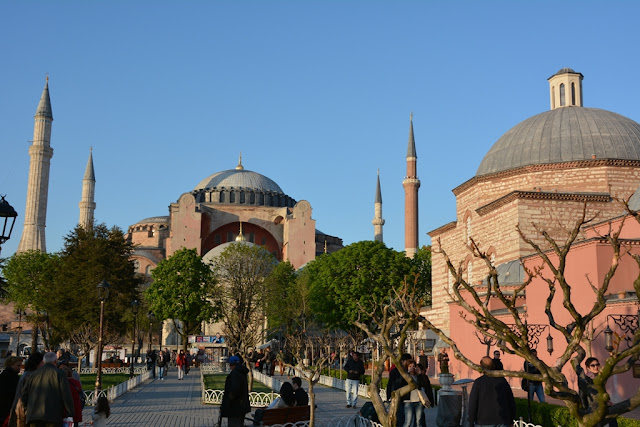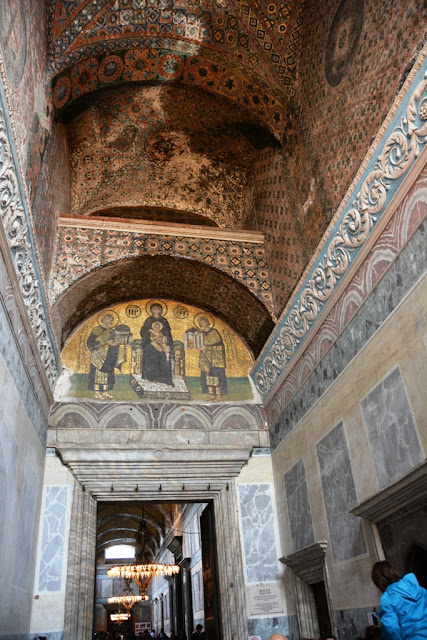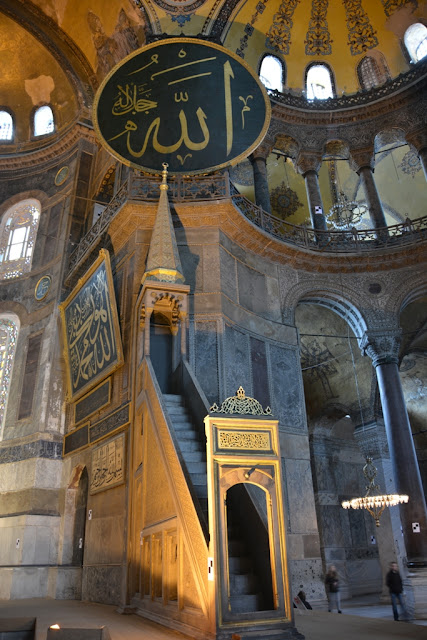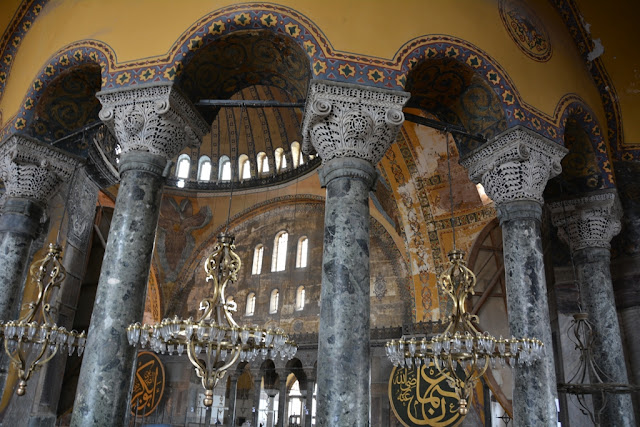In this cold spring period, we were lucky to see the Hagia Sophia on a sunny day. This half church and mosque is for us the most important building of Istanbul. The Hagia Sophia is now about 1.500 years old and was for a period of 1.000 years the biggest church in the world. Hard to imagine that the church holds such an important position in a Muslim country like Turkey.
The church transformed into a mosque in 1453 and the minarets were added over the centuries. Now the building is a museum and let us go inside to have a look at the diversity of Christian and Muslim arts and signs. A part of the Hagia Sophia is under renovation so we took only pictures of the most beautiful corners. The ceiling and the domes of the main ship still have to be restored. It remains however very impressive and what could you expect from a building that is so old.
Entering the Hagia Sophia, the first element we encounter comes from Christianity. It is the mosaic panel of “The Virgin between Justinian and Constantine”. The Emperor Constantine built the first church here on this spot. In the main hall, underneath the domes, you see eight black circular boards with the names of Allah, Mohammed, two grandsons and the 4 most important caliphs. The arches and the ceiling decorations speak to the imagination.
In the Mihrab, or the niche chamber of the mosque which is strategically placed into the direction of Mecca, you see also two of these big black wooden boards. They are in total harmony with the mosaic of the Virgin Maria in the middle of the ceiling. The Hagia Sophia is the symbol of harmony between the Islam and Christianity. Let this be an example of tolerance, peace and freedom of expression to all people in the world, independent of their religion.
In deze koude lente periode hadden we geluk dat we de Hagia Sophia konden bezoeken op een zonnige dag. Deze halve kerk, halve moskee is voor ons het belangrijkste gebouw in Istanboel. De Hagia Sophia is nu ongeveer 1.500 jaar oud en was voor 1.000 jaar de grootste kerk ter wereld van het christendom. Het is moeilijk te geloven dat een kerk zo’n belangrijke positie kan innemen in een Islamistisch land als Turkije.
De kerk werd in 1453 hervormd tot een moskee en de minaretten werden over de eeuwen heen toegevoegd. Nu is de Hagia Sophia een museum, maar laat ons binnen gaan en eens kijken naar de grote variëteit in christelijke en islamitische kunst en symbolen. Een deel van het museum is onder renovatie maar we hopen dat dit niet heel zichtbaar is op de foto’s. Het plafond en de koepels van het hoofdschip moeten nog worden hersteld. Het blijft echter enorm indrukwekkend en wat kan je verwachten van een gebouw dat zo oud is.
Aan de ingang van de Hagia Sophia worden we geconfronteerd met het eerste element van het christendom. Het is het mozaïeken paneel van “De Heilige Maagd tussen Justinian en Constantijn”. Keizer Constantijn richtte hier op deze plaats de eerste kerk op. In de hoofdhal, onder de koepels hangen er acht grote houten ronde borden met de namen van Allah, Mohammed, zijn twee kleinzonen en de vier belangrijkste kaliefen. De sierbogen en plafond versieringen spreken tot de verbeelding.
In de Mihrab of de niskamer van de moskee, die strategisch naar Mekka gericht staat, zie je ook twee van deze grote zwarte naamborden. Deze zijn in totale harmonie met de mozaïek van de Maagd Maria die in het midden van het plafond zichtbaar is. De Hagia Sophia staat symbool voor harmonie tussen de islam en het christendom. Laat dit een voorbeeld zijn van verdraagzaamheid, vrede en vrijheid van meningsuiting voor alle mensen op deze wereld, onafhankelijk van hun religieuze overtuiging..
Previous Istanbul article:
High profile but low customer satisfaction, restaurant Ulus 29
Previous Museum article:
A world tour art collection in the Victoria and Albert Museum, London
Return to main page
If Patient
57 minutes ago

























Fantastic. Turkey is my dream. Maybe next year.
ReplyDeleteNow I have seen your lovely photos I am wishing that I had had a digital camera when I visited Istanbul - I only had a film camera then.
ReplyDeleteBeautiful pictures! Didn't know Turkey was such a beautiful place.
ReplyDeleteEenheid in verscheidenheid... Mooi, Filip...
ReplyDeleteLie(f)s.
Overwhelming, Filipp! I must visit Istanbul - it is a plan since long but I haven't managed so far! Soon... very soon... Christa
ReplyDeleteLijkt me leuk om eens in het echt te zien.
ReplyDeleteLeuke foto's!
I always admire your architectural shots. The church/mosque is a unique structure and has withstood time.
ReplyDeleteThanks for the interesting history and beautiful pictures, good nightn:)
ReplyDeletecool church
ReplyDeleteIt sounds like your spring is much like ours. Today was just horribly windy! Folks were walking around outside in heavy coats and hats (as I see your people are dressed warmer too. Very few people out in shorts, but of course you always find those that do even in 30 degree temperatures! This is a lovely place and your photos are excellent! Your getting good with your new camera!
ReplyDeleteMagnificent building. It's never ceases to amaze me how such old buildings were constructed by man. It's great to see it still standing.
ReplyDeleteGreat post, wonderful photos:) Greetings
ReplyDeletegeweldig allemaal, je foto's roepen heel veel mooie herinneringen bij mij op. Als ik in de kerk/moskee stond voelde ik mij heel klein. Een fijne zondag Filip en Kristel. Groetjes Dietmut
ReplyDeleteWhat a huge mosque. Great shots but my favourites are the icons of course :)
ReplyDeleteThanks for sharing and have a nice evening.
Wonderful photos.
ReplyDeleteI've been in Hagia Sophia once, ab. 16 year old, and my memories are quite litlle.
Thanks for sharing these.
Greetings
Really glad you showed the interiors, as majestic as the exterior !
ReplyDelete